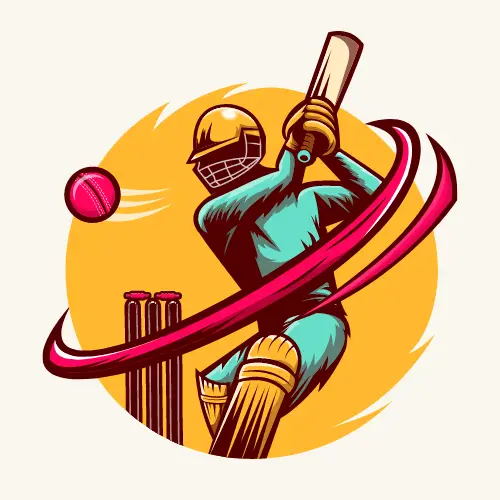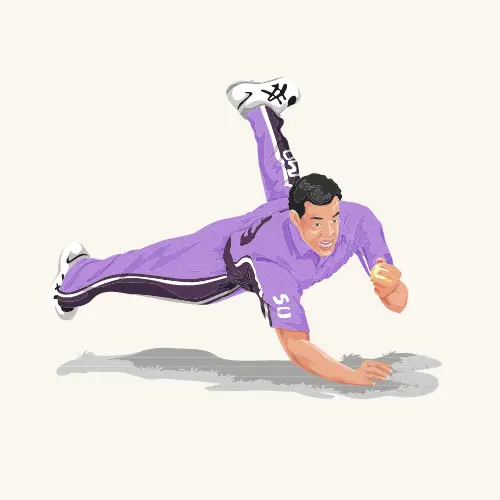How to Play Paper Cricket Dice Game Rules
Paper Cricket is a simple game that requires just paper, a pencil (or pen) and standard dice.
Paper Cricket does NOT intend to perfectly simulate the ebb and flow of a cricket match BUT from experience it does enough to provide realistic scores, averages and statistics.
Setting up game of Paper Cricket

There are 2 teams. Enter teams of fictional players and list their names in the scoresheet from 1-11. Choose a team to bat first.
The batting team
Specialist batsmen
Players 1-7 are specialist batsmen or all-rounders (players who can bat and bowl well). One of these batsmen will also be the wicket keeper (mark his/her name with a small cross).
Two of these batsmen will be your star batsmen and mark them with a star. Your wicket keeper can also be your star batsman.
Specialist Bowlers
Players 8-11 are specialist bowlers, not known for their batting skills. Draw a thick line between 7 and 11 for easy recall.

The Fielding Team
The opposing team will field. Note their four bowlers and all-rounders on the scoresheet. A team usually has 5 or 6 players bowling for them. The wicket keeper cannot bowl. Two bowlers will be the star bowlers, marked with a star. One bowler must be the weakest, marked with a small circle.
Decide game duration and overs
Decide on the game length – 40 overs is standard – with each over consisting of 6 deliveries. The batting team gets 240 balls (or dice rolls). In a 40 over game, each bowler can only bowl 8 overs, requiring at least 5 bowlers.

Paper Cricket Gameplay in Simple Steps
- Choose your first bowler, whose first delivery starts with the number one batsman.
- Roll the dice. An odd number of runs means the other batsman will face the next delivery. After the bowler completes the over, mark the runs and wickets on the scoresheet.
- Every run scored by the batsmen is marked on the scoresheet. A dot signifies no run. If a batsman is out, refer to the wicket table to determine the mode of dismissal. The next batsman on the list joins the surviving batsman.
Example:
Batsman 1 hits a four and scores a run on the second ball. Batsman 2 gets bowled out on the second ball with zero runs and facing only two balls. Batsman 3 scores a run on the first ball. Batsman 1 adds two runs on the sixth and final ball of the over.
After the first over, the batting team is at 8 runs for 1 wicket. Batsman 1 is 7 not out, and Batsman 3 is 1 not out. The next over will be bowled from the other end, and Batsman 3 will face the first ball.
When the batting team loses all ten wickets, their innings ends. Alternatively, it can conclude after a specified number of overs, like 40 overs. The total runs are then calculated to determine their score.
The opposing team becomes the batting team, filling in scoresheets as before. Their aim is to surpass the initial score. If they do, they win; otherwise, they lose.
ROLLING THE DICE
Here are charts displaying the outcomes of rolling different numbers on a standard six-sided dice. Each roll is a delivery, and six deliveries make one over. The next over starts after one bowler completes an over. Typically, two bowlers alternate, resulting in a bowling order like this: Bowler 1, Bowler 2, B1, B2, B1, B2, B1, B3, B4, B3, B4, B3, B4, B3, B4, B1, B4, B1, and so on.
Below are the runs scored by a batsman based on the type of bowler and the type of batsman.
For example, if a standard bowler is delivering to a Star Batsman and they roll a 4, the Star Batsman scores 4 runs.

Dice roll combinations required for a bowler to take a batsman’s wicket:
STAR BOWLER:
Star Batsman: 6+6 or 5+5 (e.g. roll a 6 and roll a 6 again and the batsman is out)
1-7 Batsman: 6+6 or 5+5 or 6+5+6 or 6+5+5 or 5+6+6 or 5+6+5.
8-11 Batsman: Any number rolled twice in a row.
STANDARD BOWLER:
Star Batsman: 6+6, 5+5.
1-7 Batsman: 6+6, 5+5.
8-11 Batsman: Any number rolled twice in a row.
WEAKER BOWLER:
Star Batsman: 6+6+5, 6+6+6, 5+5+5, 5+5+6.
1-7 Batsman: 6+6, 5+5.
8-11 Batsman: Any number rolled twice in a row.
Dice rolls can continue between bowlers. For instance, if an 8-11 batsman scores 1 off the last ball of the over, they will face the first ball of the next over. If they score 1 off the next delivery, they are out for rolling the same number twice in a row!
Make a dice roll to determine how the player got out.

When a player is caught out, roll two dice. The total score determines the batting order number of the catching player. For instance, if you roll a 2 and 3, batsman number 5 on the fielding team makes the catch.
Example of three overs:
Batsman 1 is Luke. Batsman 2 is Steve. Batsman 3 is Glen. Batsman 4 is Nigel. Luke and Glen are star batsmen.
Bowler 1 is Tom. Bowler 2 is Reg. Tom is a star bowler.
Over 1 (Tom):
Ball 1 to Luke. 6 rolled. Zero runs.
Ball 2 to Luke. 5 rolled. Zero runs.
Ball 3 to Luke. 2 rolled. Two runs.
Ball 4 to Luke. 3 rolled. Three runs.
Ball 5 to Steve. 3 rolled. Zero runs.
Ball 6 to Luke. 5 rolled. Zero runs.
5 runs off the over.
Over 2 (Reg):
Ball 1 to Steve. 5 rolled. Zero runs.
Ball 2 to Steve. 6 rolled. Zero runs.
Ball 3 to Steve. 5 rolled. Zero runs.
Ball 4 to Steve. 5 rolled. STEVE IS OUT. 4 rolled. Steve was bowled.
Ball 5 to Glen. 3 rolled. Three runs.
Ball 6 to Luke. 4 rolled. Four runs.
7 runs off the over. SCORE: 12 runs for 1 wicket.
Over 3 (Tom):
Ball 1 to Glen. 2 rolled. Two runs.
Ball 2 to Glen. 3 rolled. Three runs.
Ball 3 to Luke. 2 rolled. Two runs.
Ball 4 to Luke. 5 rolled. Zero runs.
Ball 5 to Luke. 5 rolled. LUKE IS OUT. 3 rolled. Luke was caught by (2+1) player 3.
Ball 6 to Nigel. 6 rolled. Zero runs.
7 runs off the over. SCORE 19 runs for 2 wickets.
Paper Cricket Scoresheet
Click here Paper Cricket Scoresheet
EXPLAINING THE SCORESHEET
A maiden is an over in which no runs are scored.
“Av” is the bowler’s average. The lower the better. Take the number of runs scored off his overs and divide it by the number of wickets he has taken. For example, a bowler conceding 40 runs but taking 4 wickets has an average of 10. His bowling figures are said to be 4 for 40.
“Ecn” is the bowler’s economy rate. The lower the better. Take the number of runs conceded and divide it by the number of overs to show the average number of runs scored off each of his overs. 37 runs off 10 overs is 3.7.
How do you win?
Add player’s scores from all events.
Player with the highest running total is the winner.

Fun games to play with just standard dice and a score sheet
Top fun games with just Standard dice Featured Games Sometimes,…